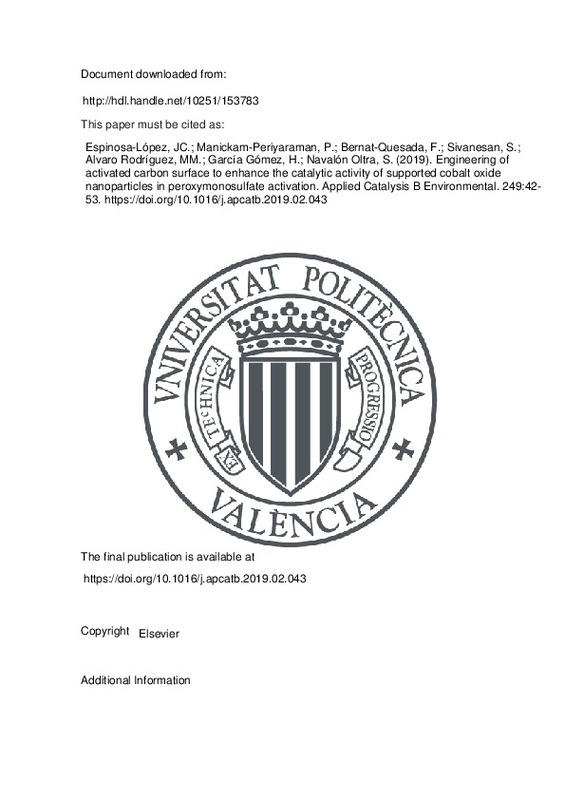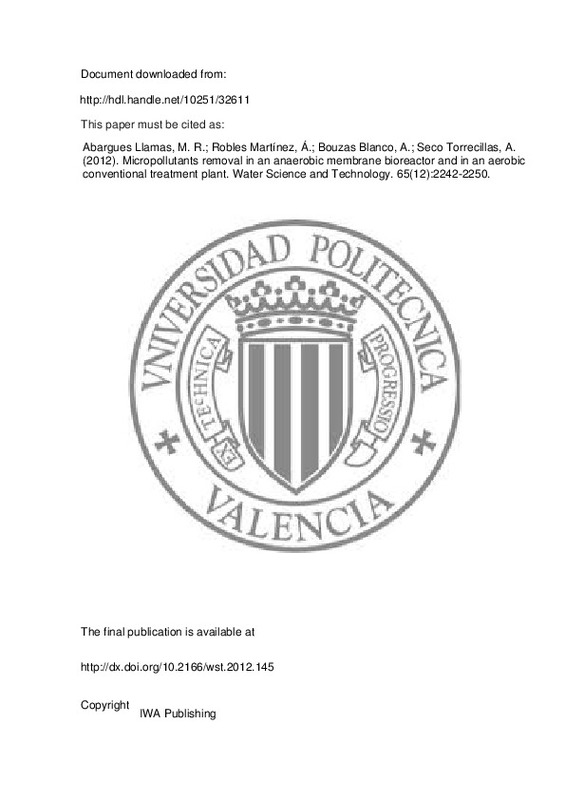JavaScript is disabled for your browser. Some features of this site may not work without it.
Buscar en RiuNet
Listar
Mi cuenta
Estadísticas
Ayuda RiuNet
Admin. UPV
Engineering of activated carbon surface to enhance the catalytic activity of supported cobalt oxide nanoparticles in peroxymonosulfate activation
Mostrar el registro sencillo del ítem
Ficheros en el ítem
| dc.contributor.author | Espinosa-López, Juan Carlos
|
es_ES |
| dc.contributor.author | Manickam-Periyaraman, Premkumar
|
es_ES |
| dc.contributor.author | Bernat-Quesada, Francisco
|
es_ES |
| dc.contributor.author | Sivanesan, Subramanian
|
es_ES |
| dc.contributor.author | Alvaro Rodríguez, Maria Mercedes
|
es_ES |
| dc.contributor.author | García Gómez, Hermenegildo
|
es_ES |
| dc.contributor.author | Navalón Oltra, Sergio
|
es_ES |
| dc.date.accessioned | 2020-10-31T04:32:11Z | |
| dc.date.available | 2020-10-31T04:32:11Z | |
| dc.date.issued | 2019-07-15 | es_ES |
| dc.identifier.issn | 0926-3373 | es_ES |
| dc.identifier.uri | http://hdl.handle.net/10251/153783 | |
| dc.description.abstract | [EN] Commercial activated carbon has been functionalized by chemical or thermal treatments to introduce surface oxygen functional groups able to anchor small cobalt nanoparticles with superior catalytic activity for peroxymonosulfate activation. The resulting activated carbon supports where characterized by combustion elemental analysis, Fourier-transformed infrared spectroscopy, Raman spectroscopy, isothermal N-2 adsorption, temperature programmed desorption/mass spectrometry, X-ray diffraction and scanning electron microscopy. Activated carbon functionalization by nitric acid resulted the most appropriated method to provide a higher population of oxygenated functional groups able to anchor small cobalt nanoparticles. The catalytic activity of supported oxidized metal nanoparticles (4.7 +/- 0.05 nm) was higher than analogous non-oxidized cobalt nanoparticles (2.9 +/- 0.14 nm). The use of analogous supported oxidized iron or copper nanoparticles resulted in lower catalytic activity. Importantly, the supported oxidized cobalt nanoparticles at 0.2 wt% loading exhibit higher activity than benchmark catalysts such as unsupported Co3O4 solid or even homogeneous Co2+ ions. This is a reflection of the relatively low estimated activation energy for both processes, peroxymonosulfate decomposition and phenol degradation. The estimated activation energy values are about 30 and 32 kJ mol(-1). The stability of the most active catalyst was assessed by performing eight consecutive uses without observing decrease of catalytic activity, neither metal leaching or metal nanoparticle aggregation. Turnover numbers/turnover frequencies values as high as 440(5)/8.10(5)h(-1) for peroxymonosulfate activation and 39.10(3)/68.10(3) h(-1) for phenol degradation at pH 7 and 20 degrees C have been estimated, respectively. Electron paramagnetic resonance measurements and selective quenching experiments revealed that the generated sulfate radicals from peroxymonosulfate rapidly are transformed in highly reactive hydroxyl radicals. In excellent agreement with previous reports, this work demonstrates the importance of an adequate activated carbon functionalization to obtain superior and stable catalysts for peroxymonosulfate activation. | es_ES |
| dc.description.sponsorship | Financial support by the Spanish Ministry of Economy and Competitiveness (Severo Ochoa, CTQ2015-65963-CQ-R1) and CTQ2014-53292-R is gratefully acknowledged. Generalitat Valenciana is also thanked for funding (Prometeo 2017/083). S.N. thanks financial support by the Fundacion Ramon Areces (XVIII Concurso Nacional para la Adjudicacion de Ayudas a la Investigacion en Ciencias de la Vida y de la Materia, 2016). | es_ES |
| dc.language | Inglés | es_ES |
| dc.publisher | Elsevier | es_ES |
| dc.relation.ispartof | Applied Catalysis B Environmental | es_ES |
| dc.rights | Reconocimiento - No comercial - Sin obra derivada (by-nc-nd) | es_ES |
| dc.subject | Heterogeneous catalysis | es_ES |
| dc.subject | Activation mechanism | |
| dc.subject | Peroxymonosulfate reagent | |
| dc.subject | Cobalt oxide nanoparticles | |
| dc.subject | Functionalized activated carbon | |
| dc.subject.classification | QUIMICA ORGANICA | es_ES |
| dc.title | Engineering of activated carbon surface to enhance the catalytic activity of supported cobalt oxide nanoparticles in peroxymonosulfate activation | es_ES |
| dc.type | Artículo | es_ES |
| dc.identifier.doi | 10.1016/j.apcatb.2019.02.043 | es_ES |
| dc.relation.projectID | info:eu-repo/grantAgreement/MINECO//CTQ2014-53292-R/ES/MATERIALES GRAFENICOS COMO CATALIZADORES PARA REACCIONES ORGANICAS./ | es_ES |
| dc.relation.projectID | info:eu-repo/grantAgreement/MINECO//CTQ2015-69153-C2-1-R/ES/EXPLOTANDO EL USO DEL GRAFENO EN CATALISIS. USO DEL GRAFENO COMO CARBOCATALIZADOR O COMO SOPORTE/ | es_ES |
| dc.relation.projectID | info:eu-repo/grantAgreement/GVA//PROMETEO%2F2017%2F083/ | es_ES |
| dc.rights.accessRights | Abierto | es_ES |
| dc.contributor.affiliation | Universitat Politècnica de València. Instituto de Tecnología Eléctrica - Institut de Tecnologia Elèctrica | es_ES |
| dc.contributor.affiliation | Universitat Politècnica de València. Departamento de Química - Departament de Química | es_ES |
| dc.description.bibliographicCitation | Espinosa-López, JC.; Manickam-Periyaraman, P.; Bernat-Quesada, F.; Sivanesan, S.; Alvaro Rodríguez, MM.; García Gómez, H.; Navalón Oltra, S. (2019). Engineering of activated carbon surface to enhance the catalytic activity of supported cobalt oxide nanoparticles in peroxymonosulfate activation. Applied Catalysis B Environmental. 249:42-53. https://doi.org/10.1016/j.apcatb.2019.02.043 | es_ES |
| dc.description.accrualMethod | S | es_ES |
| dc.relation.publisherversion | https://doi.org/10.1016/j.apcatb.2019.02.043 | es_ES |
| dc.description.upvformatpinicio | 42 | es_ES |
| dc.description.upvformatpfin | 53 | es_ES |
| dc.type.version | info:eu-repo/semantics/publishedVersion | es_ES |
| dc.description.volume | 249 | es_ES |
| dc.relation.pasarela | S\407063 | es_ES |
| dc.contributor.funder | Generalitat Valenciana | es_ES |
| dc.contributor.funder | Fundación Ramón Areces | es_ES |
| dc.contributor.funder | Ministerio de Economía y Competitividad | es_ES |







![[Cerrado]](/themes/UPV/images/candado.png)


